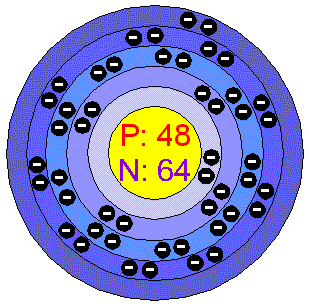|

|
|

|
CadmiumCadmium is a lustrous, Silver-white, ductile, very malleable metal. Its surface has a bluish tinge and the metal is soft enough to be cut with a knife, but it tarnishes in air. It is soluble in acids but not in alkalis. It is similar in many respects to Zinc but it forms more complex compounds. Applications About three-fourths of Cadmium is used in Ni-Cd batteries, most of the remaining one-fourth is used mainly for pigments, coatings and plating, and as stabilizers for plastics. Cadium has been used particularly to electroplate steel where a film of Cadmium only 0.05 mm thick will provide complete protection against the sea. Cadmium has the ability to absorb neutrons, so it is used as a barrier to control nuclear fission. Cadmium in the environment Cadmium can mainly be found in the earth's crust. It always occurs in combination with Zinc. Cadmium also consists in the industries as an inevitable by-product of Zinc, lead and Copper extraction. After being applied it enters the envIronment mainly through the ground, because it is found in manures and pesticides. Naturally a very large amount of Cadmium is released into the environment, about 25,000 tons a year. About half of this Cadmium is released into rivers through weathering of rocks and some Cadmium is released into air through forest fires and volcanoes. The rest of the Cadmium is released through human activities, such as manufacturing. No Cadmium ore is mined for the metal, because more than enough is produced as a byproduct of the smelting of Zinc from its ore, sphelerite (ZnS), in which CdS is a significant impurity, making up as much as 3%. Consequently, the main mining areas are those associated with Zinc. World production is around 14.000 tonnes per year, the main producing country is Canada, with the USA, Australia, Mexico, JApan and Peru also being the major suppliers. Health effects of CadmiumHuman uptake of Cadmium takes place mainly through food.
Foodstuffs that are rich in Cadmium can greatly increase the
Cadmium concentration in human bodies. Examples are liver,
mushrooms, shellfish, mussels, cocoa powder and dried seaweed. Environmental effects of CadmiumCadmium waste streams from the industries mainly end up in soils.
The causes of these waste streams are for instance Zinc
production, phosphate ore implication and bio industrial manure.
Cadmium waste streams may also enter the air through (household)
waste combustion and burning of fossil fuels. Because of
regulations only little Cadmium now enters the water through
disposal of wastewater from households or industries. |